Restorative Justice Assignment: Meeting the Needs of Justice and Benefits of Restorative Justice
VerifiedAdded on 2023/06/11
|15
|3802
|499
AI Summary
This assignment explores the concept of restorative justice, its benefits, and typology. It also discusses the balance between victim and offender, with a focus on sexual violence. The subject is relevant to law and criminology courses in universities and colleges.
Contribute Materials
Your contribution can guide someone’s learning journey. Share your
documents today.
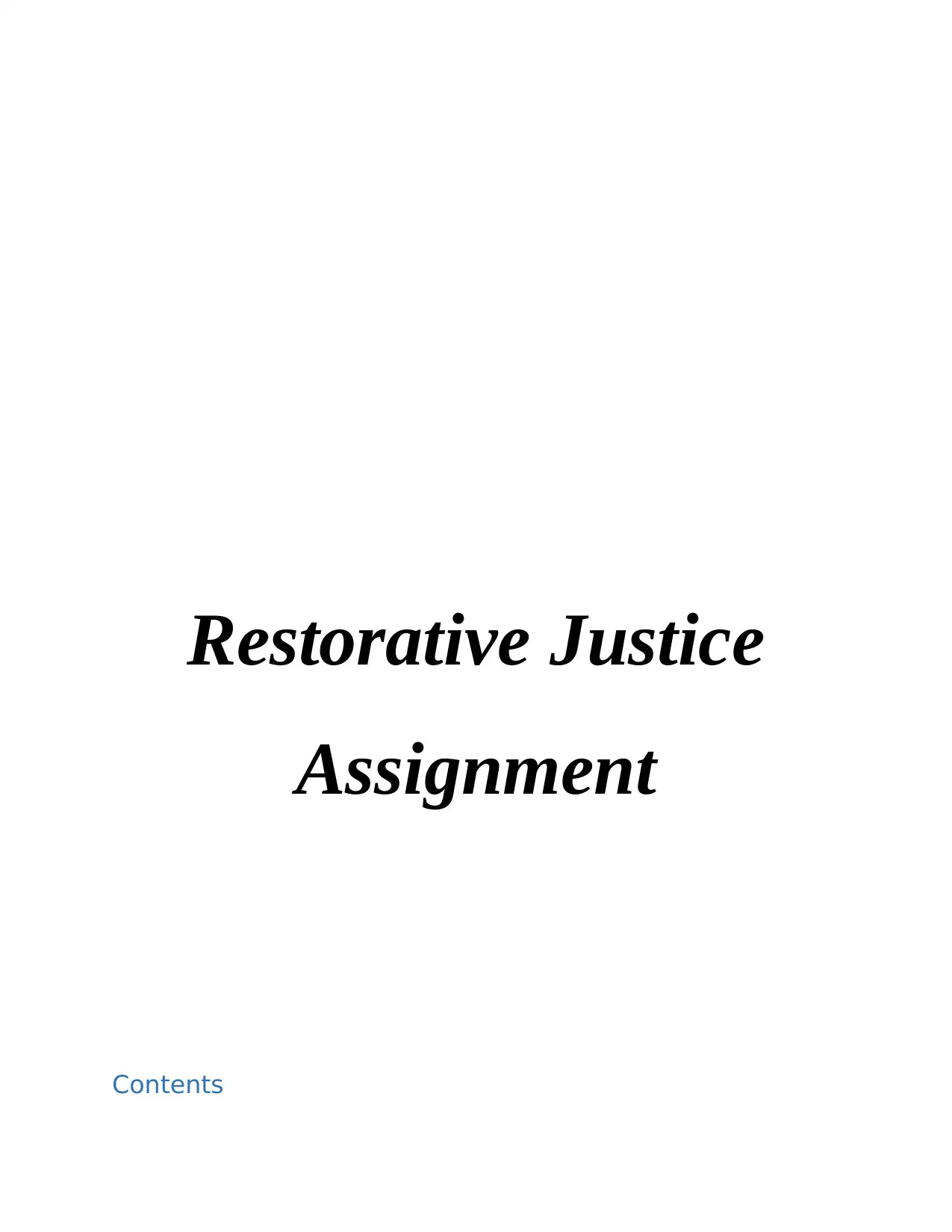
Restorative Justice
Assignment
Contents
Assignment
Contents
Secure Best Marks with AI Grader
Need help grading? Try our AI Grader for instant feedback on your assignments.
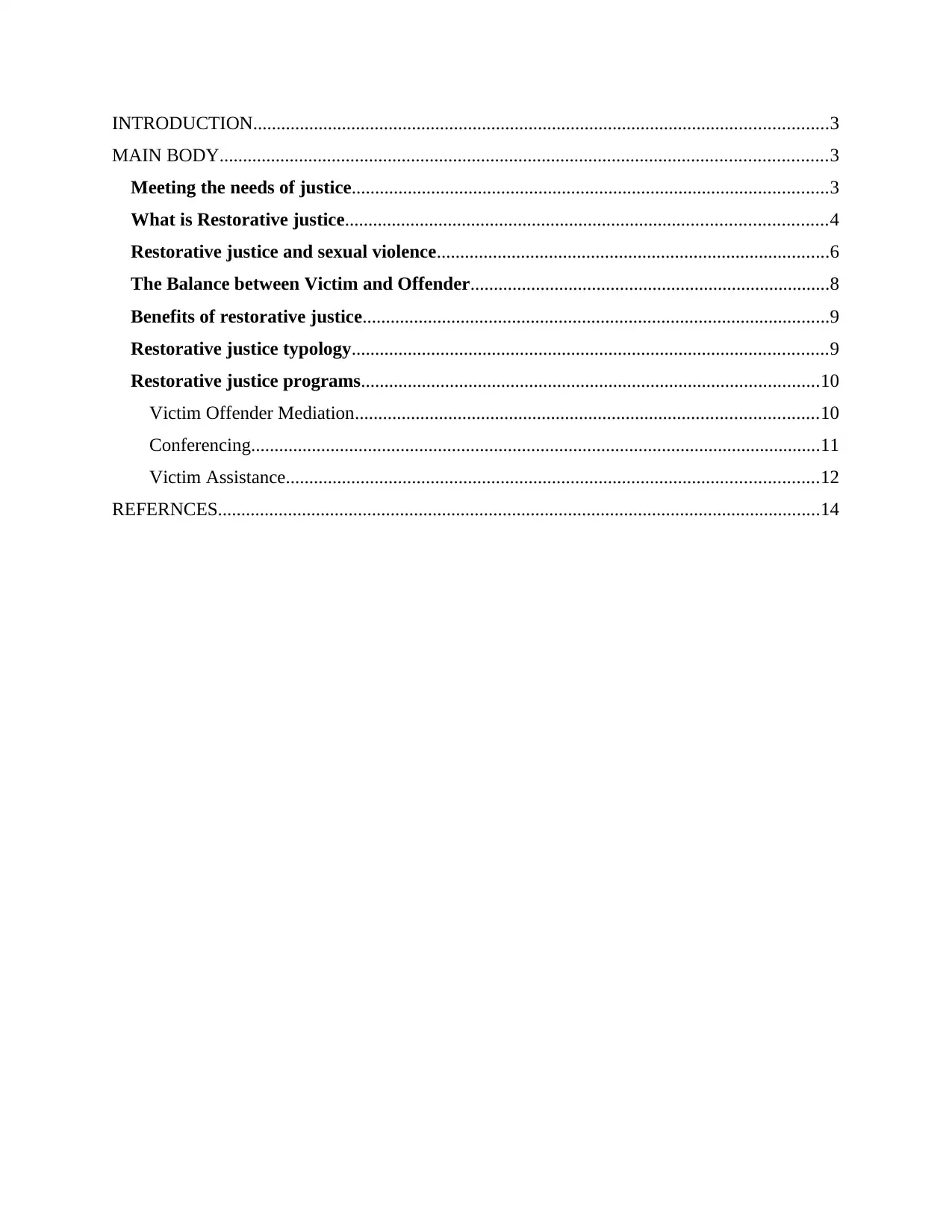
INTRODUCTION...........................................................................................................................3
MAIN BODY..................................................................................................................................3
Meeting the needs of justice......................................................................................................3
What is Restorative justice.......................................................................................................4
Restorative justice and sexual violence....................................................................................6
The Balance between Victim and Offender.............................................................................8
Benefits of restorative justice....................................................................................................9
Restorative justice typology......................................................................................................9
Restorative justice programs..................................................................................................10
Victim Offender Mediation...................................................................................................10
Conferencing..........................................................................................................................11
Victim Assistance..................................................................................................................12
REFERNCES.................................................................................................................................14
MAIN BODY..................................................................................................................................3
Meeting the needs of justice......................................................................................................3
What is Restorative justice.......................................................................................................4
Restorative justice and sexual violence....................................................................................6
The Balance between Victim and Offender.............................................................................8
Benefits of restorative justice....................................................................................................9
Restorative justice typology......................................................................................................9
Restorative justice programs..................................................................................................10
Victim Offender Mediation...................................................................................................10
Conferencing..........................................................................................................................11
Victim Assistance..................................................................................................................12
REFERNCES.................................................................................................................................14

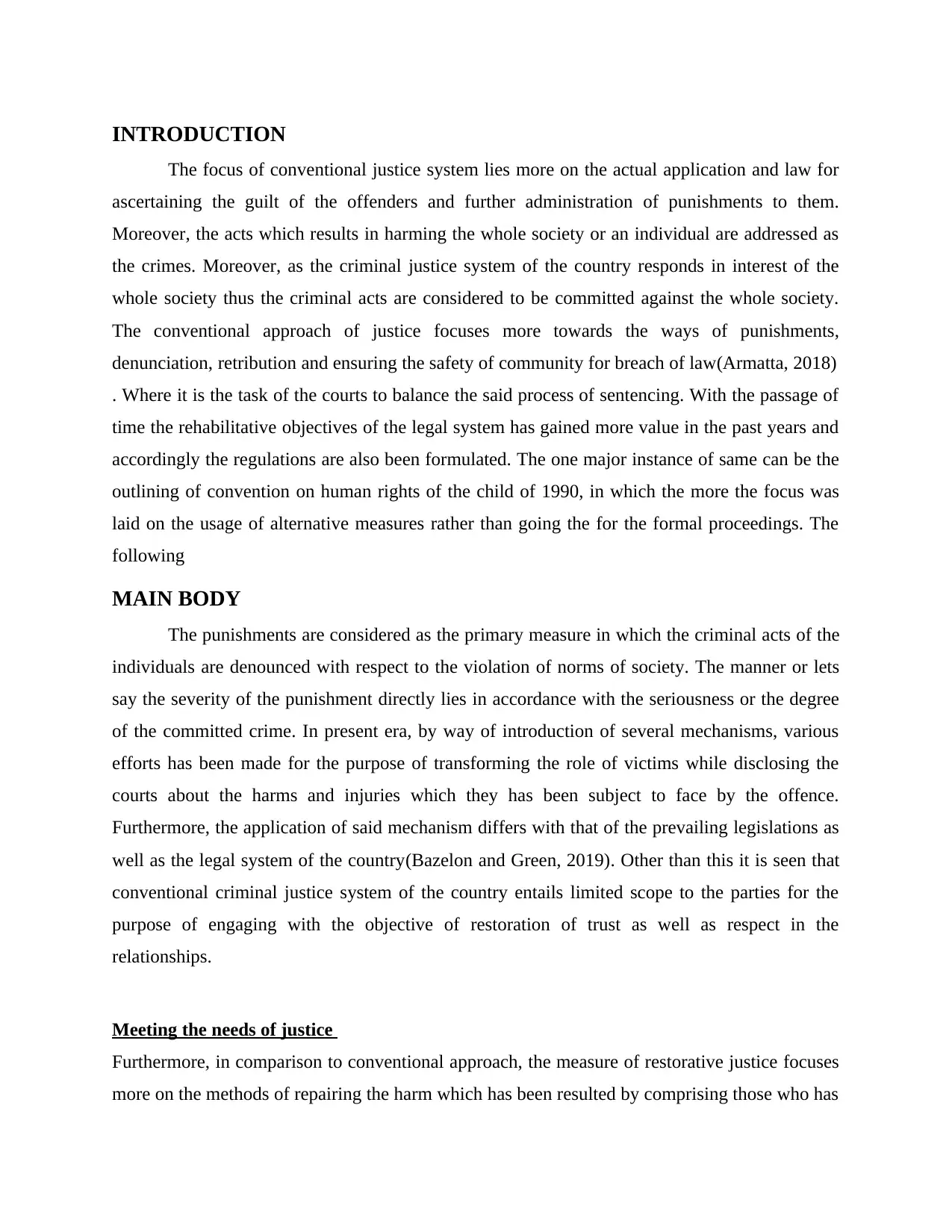
INTRODUCTION
The focus of conventional justice system lies more on the actual application and law for
ascertaining the guilt of the offenders and further administration of punishments to them.
Moreover, the acts which results in harming the whole society or an individual are addressed as
the crimes. Moreover, as the criminal justice system of the country responds in interest of the
whole society thus the criminal acts are considered to be committed against the whole society.
The conventional approach of justice focuses more towards the ways of punishments,
denunciation, retribution and ensuring the safety of community for breach of law(Armatta, 2018)
. Where it is the task of the courts to balance the said process of sentencing. With the passage of
time the rehabilitative objectives of the legal system has gained more value in the past years and
accordingly the regulations are also been formulated. The one major instance of same can be the
outlining of convention on human rights of the child of 1990, in which the more the focus was
laid on the usage of alternative measures rather than going the for the formal proceedings. The
following
MAIN BODY
The punishments are considered as the primary measure in which the criminal acts of the
individuals are denounced with respect to the violation of norms of society. The manner or lets
say the severity of the punishment directly lies in accordance with the seriousness or the degree
of the committed crime. In present era, by way of introduction of several mechanisms, various
efforts has been made for the purpose of transforming the role of victims while disclosing the
courts about the harms and injuries which they has been subject to face by the offence.
Furthermore, the application of said mechanism differs with that of the prevailing legislations as
well as the legal system of the country(Bazelon and Green, 2019). Other than this it is seen that
conventional criminal justice system of the country entails limited scope to the parties for the
purpose of engaging with the objective of restoration of trust as well as respect in the
relationships.
Meeting the needs of justice
Furthermore, in comparison to conventional approach, the measure of restorative justice focuses
more on the methods of repairing the harm which has been resulted by comprising those who has
The focus of conventional justice system lies more on the actual application and law for
ascertaining the guilt of the offenders and further administration of punishments to them.
Moreover, the acts which results in harming the whole society or an individual are addressed as
the crimes. Moreover, as the criminal justice system of the country responds in interest of the
whole society thus the criminal acts are considered to be committed against the whole society.
The conventional approach of justice focuses more towards the ways of punishments,
denunciation, retribution and ensuring the safety of community for breach of law(Armatta, 2018)
. Where it is the task of the courts to balance the said process of sentencing. With the passage of
time the rehabilitative objectives of the legal system has gained more value in the past years and
accordingly the regulations are also been formulated. The one major instance of same can be the
outlining of convention on human rights of the child of 1990, in which the more the focus was
laid on the usage of alternative measures rather than going the for the formal proceedings. The
following
MAIN BODY
The punishments are considered as the primary measure in which the criminal acts of the
individuals are denounced with respect to the violation of norms of society. The manner or lets
say the severity of the punishment directly lies in accordance with the seriousness or the degree
of the committed crime. In present era, by way of introduction of several mechanisms, various
efforts has been made for the purpose of transforming the role of victims while disclosing the
courts about the harms and injuries which they has been subject to face by the offence.
Furthermore, the application of said mechanism differs with that of the prevailing legislations as
well as the legal system of the country(Bazelon and Green, 2019). Other than this it is seen that
conventional criminal justice system of the country entails limited scope to the parties for the
purpose of engaging with the objective of restoration of trust as well as respect in the
relationships.
Meeting the needs of justice
Furthermore, in comparison to conventional approach, the measure of restorative justice focuses
more on the methods of repairing the harm which has been resulted by comprising those who has
Secure Best Marks with AI Grader
Need help grading? Try our AI Grader for instant feedback on your assignments.
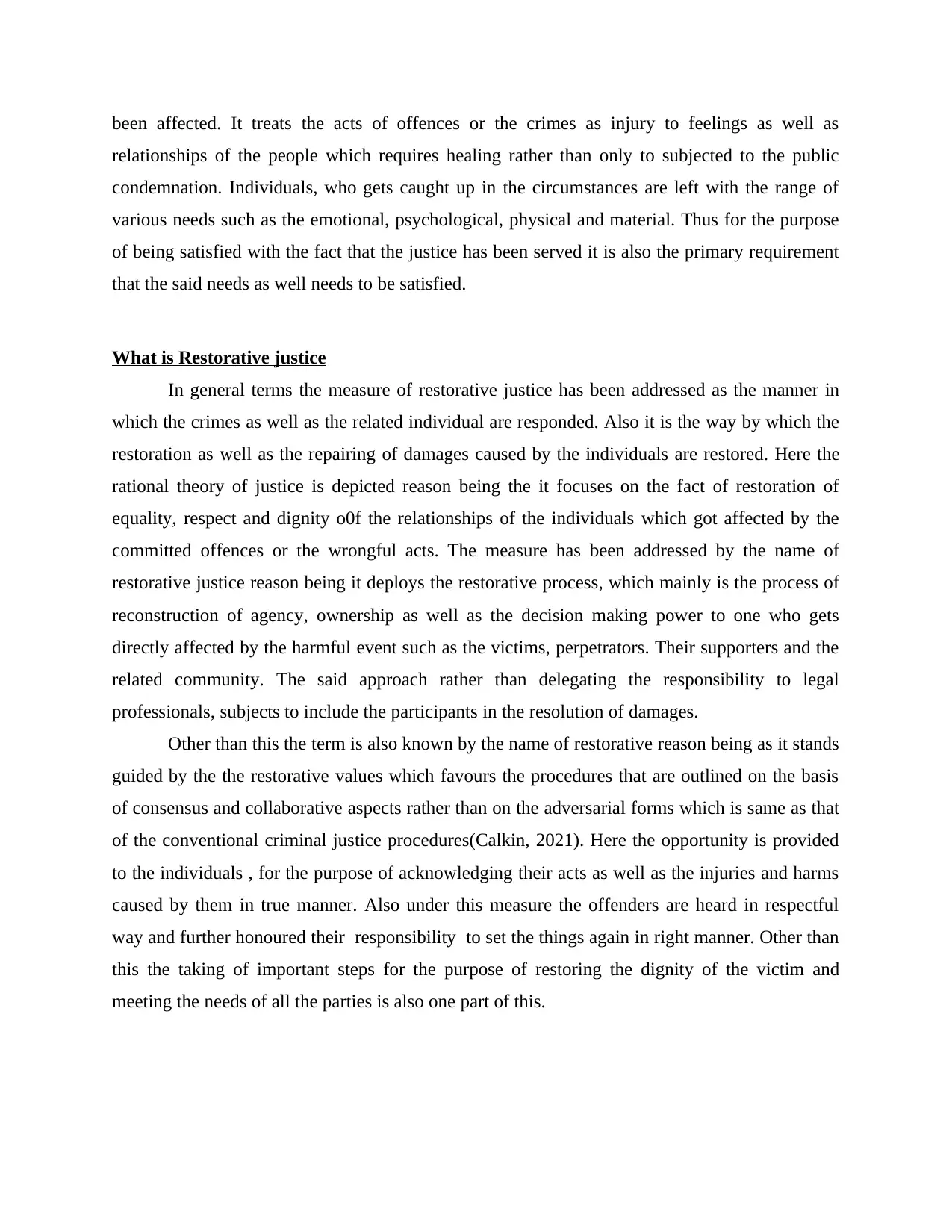
been affected. It treats the acts of offences or the crimes as injury to feelings as well as
relationships of the people which requires healing rather than only to subjected to the public
condemnation. Individuals, who gets caught up in the circumstances are left with the range of
various needs such as the emotional, psychological, physical and material. Thus for the purpose
of being satisfied with the fact that the justice has been served it is also the primary requirement
that the said needs as well needs to be satisfied.
What is Restorative justice
In general terms the measure of restorative justice has been addressed as the manner in
which the crimes as well as the related individual are responded. Also it is the way by which the
restoration as well as the repairing of damages caused by the individuals are restored. Here the
rational theory of justice is depicted reason being the it focuses on the fact of restoration of
equality, respect and dignity o0f the relationships of the individuals which got affected by the
committed offences or the wrongful acts. The measure has been addressed by the name of
restorative justice reason being it deploys the restorative process, which mainly is the process of
reconstruction of agency, ownership as well as the decision making power to one who gets
directly affected by the harmful event such as the victims, perpetrators. Their supporters and the
related community. The said approach rather than delegating the responsibility to legal
professionals, subjects to include the participants in the resolution of damages.
Other than this the term is also known by the name of restorative reason being as it stands
guided by the the restorative values which favours the procedures that are outlined on the basis
of consensus and collaborative aspects rather than on the adversarial forms which is same as that
of the conventional criminal justice procedures(Calkin, 2021). Here the opportunity is provided
to the individuals , for the purpose of acknowledging their acts as well as the injuries and harms
caused by them in true manner. Also under this measure the offenders are heard in respectful
way and further honoured their responsibility to set the things again in right manner. Other than
this the taking of important steps for the purpose of restoring the dignity of the victim and
meeting the needs of all the parties is also one part of this.
relationships of the people which requires healing rather than only to subjected to the public
condemnation. Individuals, who gets caught up in the circumstances are left with the range of
various needs such as the emotional, psychological, physical and material. Thus for the purpose
of being satisfied with the fact that the justice has been served it is also the primary requirement
that the said needs as well needs to be satisfied.
What is Restorative justice
In general terms the measure of restorative justice has been addressed as the manner in
which the crimes as well as the related individual are responded. Also it is the way by which the
restoration as well as the repairing of damages caused by the individuals are restored. Here the
rational theory of justice is depicted reason being the it focuses on the fact of restoration of
equality, respect and dignity o0f the relationships of the individuals which got affected by the
committed offences or the wrongful acts. The measure has been addressed by the name of
restorative justice reason being it deploys the restorative process, which mainly is the process of
reconstruction of agency, ownership as well as the decision making power to one who gets
directly affected by the harmful event such as the victims, perpetrators. Their supporters and the
related community. The said approach rather than delegating the responsibility to legal
professionals, subjects to include the participants in the resolution of damages.
Other than this the term is also known by the name of restorative reason being as it stands
guided by the the restorative values which favours the procedures that are outlined on the basis
of consensus and collaborative aspects rather than on the adversarial forms which is same as that
of the conventional criminal justice procedures(Calkin, 2021). Here the opportunity is provided
to the individuals , for the purpose of acknowledging their acts as well as the injuries and harms
caused by them in true manner. Also under this measure the offenders are heard in respectful
way and further honoured their responsibility to set the things again in right manner. Other than
this the taking of important steps for the purpose of restoring the dignity of the victim and
meeting the needs of all the parties is also one part of this.
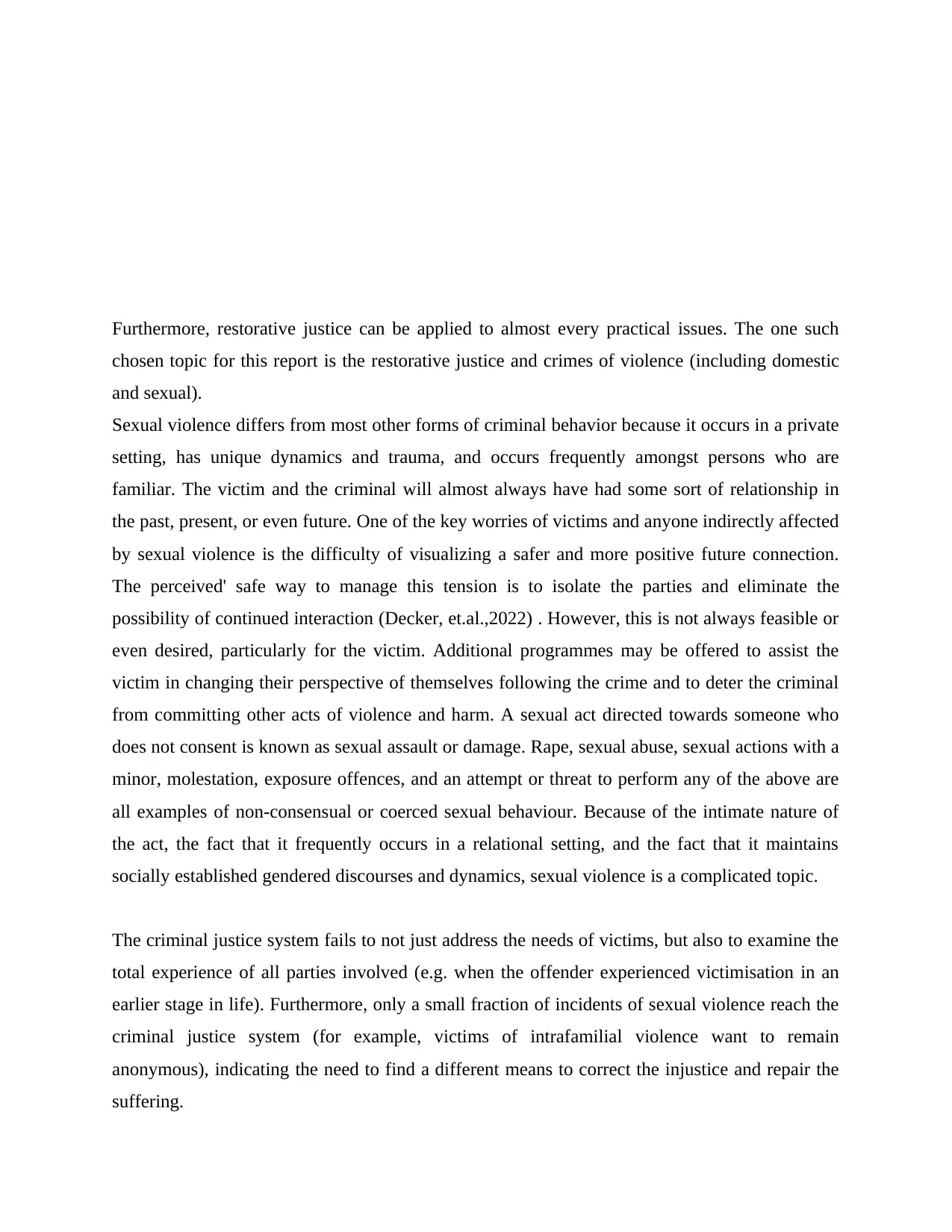
Furthermore, restorative justice can be applied to almost every practical issues. The one such
chosen topic for this report is the restorative justice and crimes of violence (including domestic
and sexual).
Sexual violence differs from most other forms of criminal behavior because it occurs in a private
setting, has unique dynamics and trauma, and occurs frequently amongst persons who are
familiar. The victim and the criminal will almost always have had some sort of relationship in
the past, present, or even future. One of the key worries of victims and anyone indirectly affected
by sexual violence is the difficulty of visualizing a safer and more positive future connection.
The perceived' safe way to manage this tension is to isolate the parties and eliminate the
possibility of continued interaction (Decker, et.al.,2022) . However, this is not always feasible or
even desired, particularly for the victim. Additional programmes may be offered to assist the
victim in changing their perspective of themselves following the crime and to deter the criminal
from committing other acts of violence and harm. A sexual act directed towards someone who
does not consent is known as sexual assault or damage. Rape, sexual abuse, sexual actions with a
minor, molestation, exposure offences, and an attempt or threat to perform any of the above are
all examples of non-consensual or coerced sexual behaviour. Because of the intimate nature of
the act, the fact that it frequently occurs in a relational setting, and the fact that it maintains
socially established gendered discourses and dynamics, sexual violence is a complicated topic.
The criminal justice system fails to not just address the needs of victims, but also to examine the
total experience of all parties involved (e.g. when the offender experienced victimisation in an
earlier stage in life). Furthermore, only a small fraction of incidents of sexual violence reach the
criminal justice system (for example, victims of intrafamilial violence want to remain
anonymous), indicating the need to find a different means to correct the injustice and repair the
suffering.
chosen topic for this report is the restorative justice and crimes of violence (including domestic
and sexual).
Sexual violence differs from most other forms of criminal behavior because it occurs in a private
setting, has unique dynamics and trauma, and occurs frequently amongst persons who are
familiar. The victim and the criminal will almost always have had some sort of relationship in
the past, present, or even future. One of the key worries of victims and anyone indirectly affected
by sexual violence is the difficulty of visualizing a safer and more positive future connection.
The perceived' safe way to manage this tension is to isolate the parties and eliminate the
possibility of continued interaction (Decker, et.al.,2022) . However, this is not always feasible or
even desired, particularly for the victim. Additional programmes may be offered to assist the
victim in changing their perspective of themselves following the crime and to deter the criminal
from committing other acts of violence and harm. A sexual act directed towards someone who
does not consent is known as sexual assault or damage. Rape, sexual abuse, sexual actions with a
minor, molestation, exposure offences, and an attempt or threat to perform any of the above are
all examples of non-consensual or coerced sexual behaviour. Because of the intimate nature of
the act, the fact that it frequently occurs in a relational setting, and the fact that it maintains
socially established gendered discourses and dynamics, sexual violence is a complicated topic.
The criminal justice system fails to not just address the needs of victims, but also to examine the
total experience of all parties involved (e.g. when the offender experienced victimisation in an
earlier stage in life). Furthermore, only a small fraction of incidents of sexual violence reach the
criminal justice system (for example, victims of intrafamilial violence want to remain
anonymous), indicating the need to find a different means to correct the injustice and repair the
suffering.
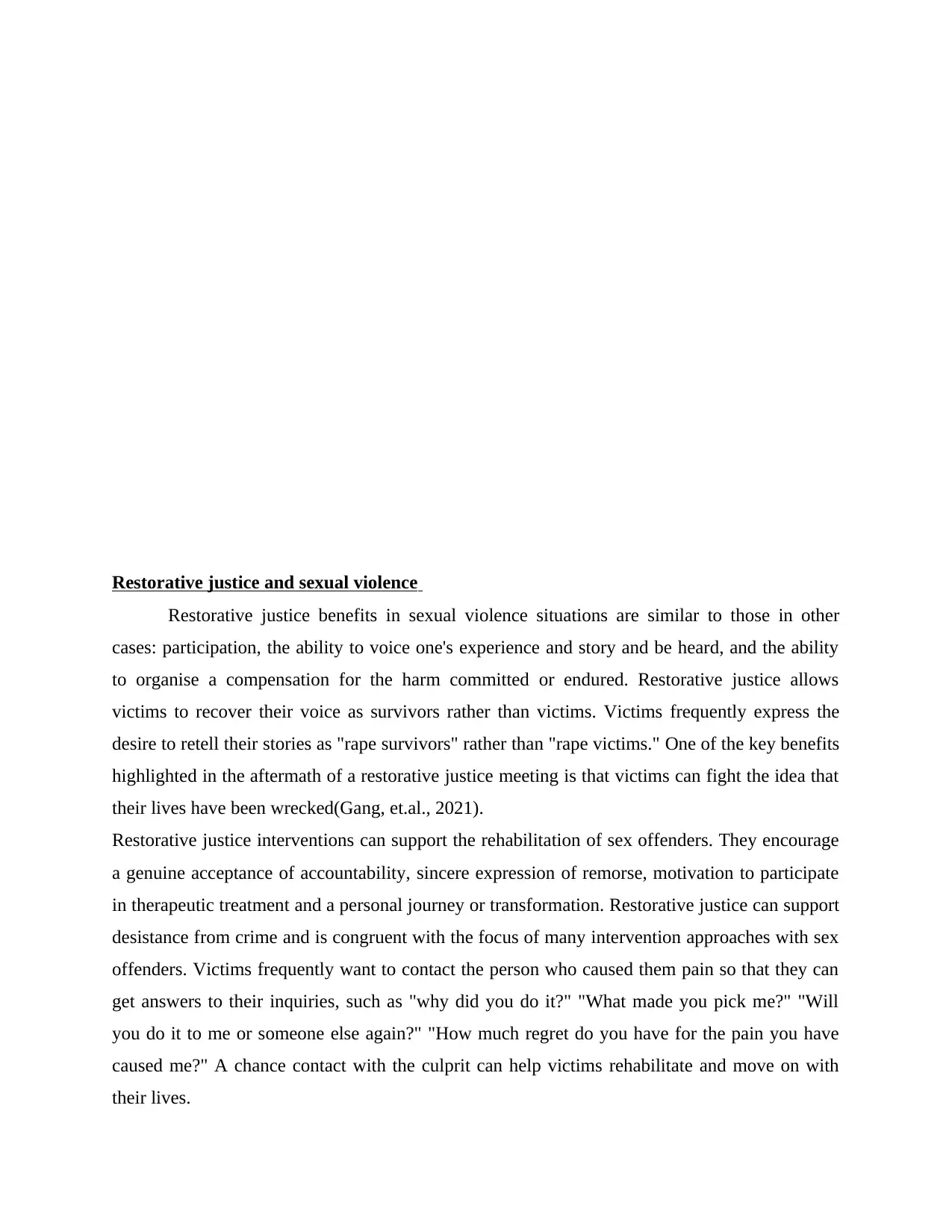
Restorative justice and sexual violence
Restorative justice benefits in sexual violence situations are similar to those in other
cases: participation, the ability to voice one's experience and story and be heard, and the ability
to organise a compensation for the harm committed or endured. Restorative justice allows
victims to recover their voice as survivors rather than victims. Victims frequently express the
desire to retell their stories as "rape survivors" rather than "rape victims." One of the key benefits
highlighted in the aftermath of a restorative justice meeting is that victims can fight the idea that
their lives have been wrecked(Gang, et.al., 2021).
Restorative justice interventions can support the rehabilitation of sex offenders. They encourage
a genuine acceptance of accountability, sincere expression of remorse, motivation to participate
in therapeutic treatment and a personal journey or transformation. Restorative justice can support
desistance from crime and is congruent with the focus of many intervention approaches with sex
offenders. Victims frequently want to contact the person who caused them pain so that they can
get answers to their inquiries, such as "why did you do it?" "What made you pick me?" "Will
you do it to me or someone else again?" "How much regret do you have for the pain you have
caused me?" A chance contact with the culprit can help victims rehabilitate and move on with
their lives.
Restorative justice benefits in sexual violence situations are similar to those in other
cases: participation, the ability to voice one's experience and story and be heard, and the ability
to organise a compensation for the harm committed or endured. Restorative justice allows
victims to recover their voice as survivors rather than victims. Victims frequently express the
desire to retell their stories as "rape survivors" rather than "rape victims." One of the key benefits
highlighted in the aftermath of a restorative justice meeting is that victims can fight the idea that
their lives have been wrecked(Gang, et.al., 2021).
Restorative justice interventions can support the rehabilitation of sex offenders. They encourage
a genuine acceptance of accountability, sincere expression of remorse, motivation to participate
in therapeutic treatment and a personal journey or transformation. Restorative justice can support
desistance from crime and is congruent with the focus of many intervention approaches with sex
offenders. Victims frequently want to contact the person who caused them pain so that they can
get answers to their inquiries, such as "why did you do it?" "What made you pick me?" "Will
you do it to me or someone else again?" "How much regret do you have for the pain you have
caused me?" A chance contact with the culprit can help victims rehabilitate and move on with
their lives.
Paraphrase This Document
Need a fresh take? Get an instant paraphrase of this document with our AI Paraphraser
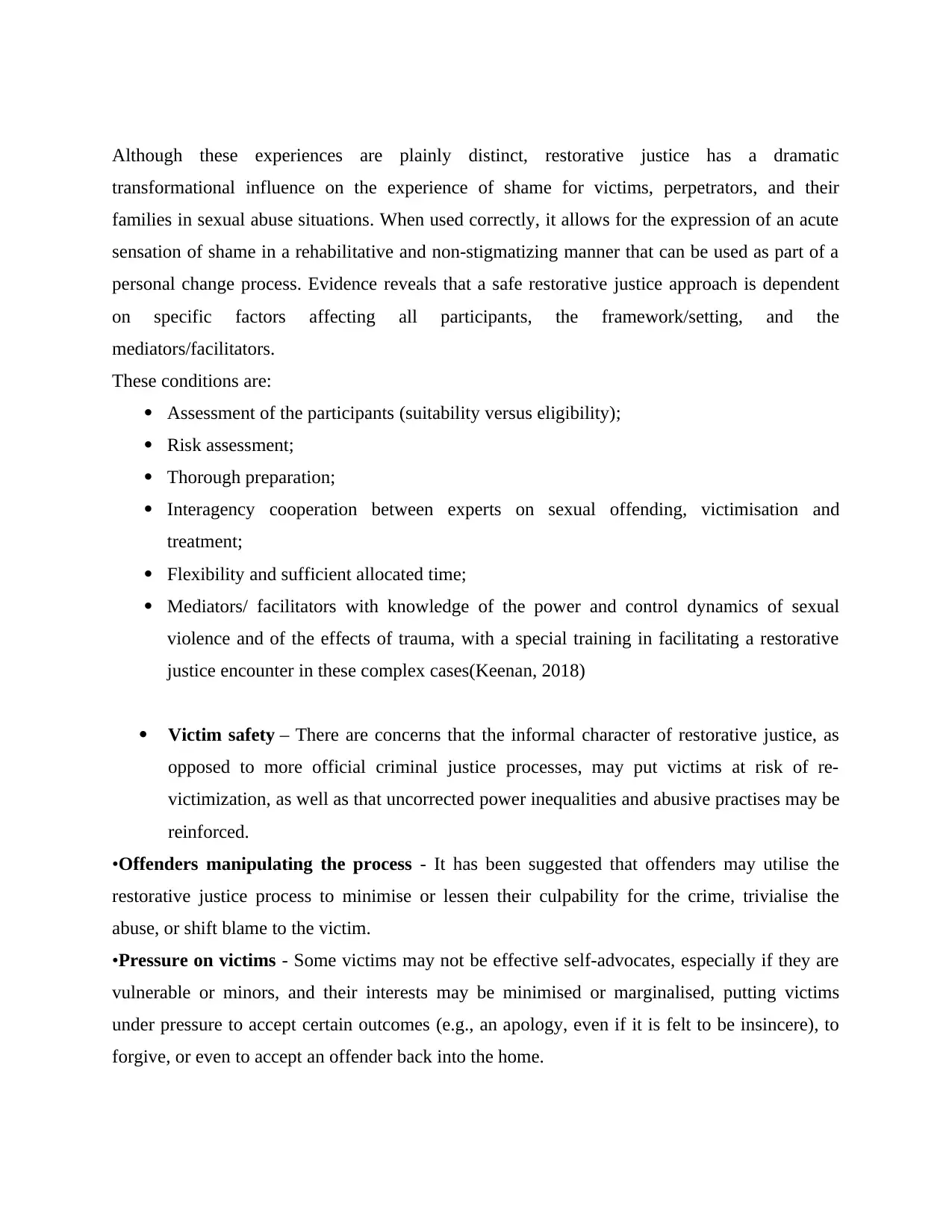
Although these experiences are plainly distinct, restorative justice has a dramatic
transformational influence on the experience of shame for victims, perpetrators, and their
families in sexual abuse situations. When used correctly, it allows for the expression of an acute
sensation of shame in a rehabilitative and non-stigmatizing manner that can be used as part of a
personal change process. Evidence reveals that a safe restorative justice approach is dependent
on specific factors affecting all participants, the framework/setting, and the
mediators/facilitators.
These conditions are:
Assessment of the participants (suitability versus eligibility);
Risk assessment;
Thorough preparation;
Interagency cooperation between experts on sexual offending, victimisation and
treatment;
Flexibility and sufficient allocated time;
Mediators/ facilitators with knowledge of the power and control dynamics of sexual
violence and of the effects of trauma, with a special training in facilitating a restorative
justice encounter in these complex cases(Keenan, 2018)
Victim safety – There are concerns that the informal character of restorative justice, as
opposed to more official criminal justice processes, may put victims at risk of re-
victimization, as well as that uncorrected power inequalities and abusive practises may be
reinforced.
•Offenders manipulating the process - It has been suggested that offenders may utilise the
restorative justice process to minimise or lessen their culpability for the crime, trivialise the
abuse, or shift blame to the victim.
•Pressure on victims - Some victims may not be effective self-advocates, especially if they are
vulnerable or minors, and their interests may be minimised or marginalised, putting victims
under pressure to accept certain outcomes (e.g., an apology, even if it is felt to be insincere), to
forgive, or even to accept an offender back into the home.
transformational influence on the experience of shame for victims, perpetrators, and their
families in sexual abuse situations. When used correctly, it allows for the expression of an acute
sensation of shame in a rehabilitative and non-stigmatizing manner that can be used as part of a
personal change process. Evidence reveals that a safe restorative justice approach is dependent
on specific factors affecting all participants, the framework/setting, and the
mediators/facilitators.
These conditions are:
Assessment of the participants (suitability versus eligibility);
Risk assessment;
Thorough preparation;
Interagency cooperation between experts on sexual offending, victimisation and
treatment;
Flexibility and sufficient allocated time;
Mediators/ facilitators with knowledge of the power and control dynamics of sexual
violence and of the effects of trauma, with a special training in facilitating a restorative
justice encounter in these complex cases(Keenan, 2018)
Victim safety – There are concerns that the informal character of restorative justice, as
opposed to more official criminal justice processes, may put victims at risk of re-
victimization, as well as that uncorrected power inequalities and abusive practises may be
reinforced.
•Offenders manipulating the process - It has been suggested that offenders may utilise the
restorative justice process to minimise or lessen their culpability for the crime, trivialise the
abuse, or shift blame to the victim.
•Pressure on victims - Some victims may not be effective self-advocates, especially if they are
vulnerable or minors, and their interests may be minimised or marginalised, putting victims
under pressure to accept certain outcomes (e.g., an apology, even if it is felt to be insincere), to
forgive, or even to accept an offender back into the home.
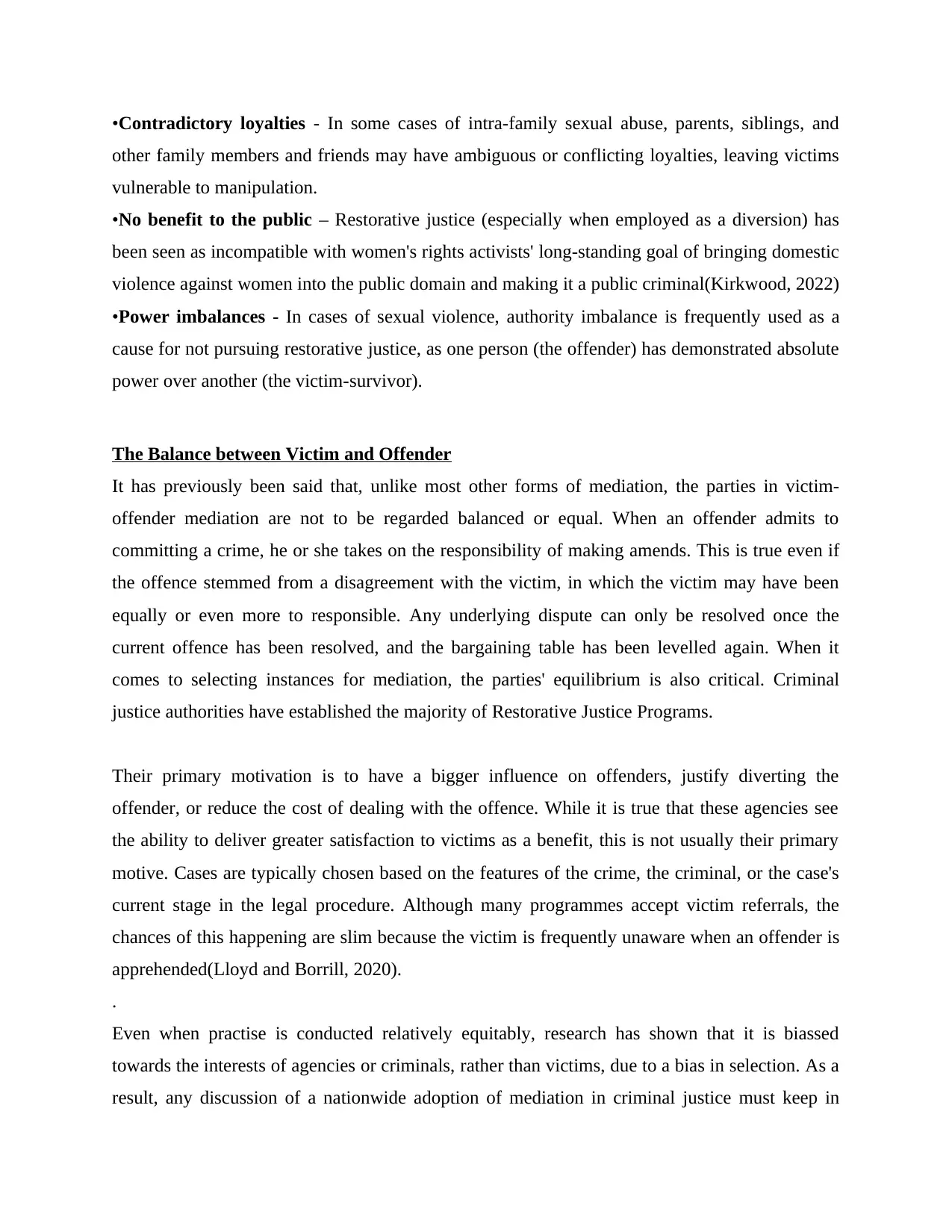
•Contradictory loyalties - In some cases of intra-family sexual abuse, parents, siblings, and
other family members and friends may have ambiguous or conflicting loyalties, leaving victims
vulnerable to manipulation.
•No benefit to the public – Restorative justice (especially when employed as a diversion) has
been seen as incompatible with women's rights activists' long-standing goal of bringing domestic
violence against women into the public domain and making it a public criminal(Kirkwood, 2022)
•Power imbalances - In cases of sexual violence, authority imbalance is frequently used as a
cause for not pursuing restorative justice, as one person (the offender) has demonstrated absolute
power over another (the victim-survivor).
The Balance between Victim and Offender
It has previously been said that, unlike most other forms of mediation, the parties in victim-
offender mediation are not to be regarded balanced or equal. When an offender admits to
committing a crime, he or she takes on the responsibility of making amends. This is true even if
the offence stemmed from a disagreement with the victim, in which the victim may have been
equally or even more to responsible. Any underlying dispute can only be resolved once the
current offence has been resolved, and the bargaining table has been levelled again. When it
comes to selecting instances for mediation, the parties' equilibrium is also critical. Criminal
justice authorities have established the majority of Restorative Justice Programs.
Their primary motivation is to have a bigger influence on offenders, justify diverting the
offender, or reduce the cost of dealing with the offence. While it is true that these agencies see
the ability to deliver greater satisfaction to victims as a benefit, this is not usually their primary
motive. Cases are typically chosen based on the features of the crime, the criminal, or the case's
current stage in the legal procedure. Although many programmes accept victim referrals, the
chances of this happening are slim because the victim is frequently unaware when an offender is
apprehended(Lloyd and Borrill, 2020).
.
Even when practise is conducted relatively equitably, research has shown that it is biassed
towards the interests of agencies or criminals, rather than victims, due to a bias in selection. As a
result, any discussion of a nationwide adoption of mediation in criminal justice must keep in
other family members and friends may have ambiguous or conflicting loyalties, leaving victims
vulnerable to manipulation.
•No benefit to the public – Restorative justice (especially when employed as a diversion) has
been seen as incompatible with women's rights activists' long-standing goal of bringing domestic
violence against women into the public domain and making it a public criminal(Kirkwood, 2022)
•Power imbalances - In cases of sexual violence, authority imbalance is frequently used as a
cause for not pursuing restorative justice, as one person (the offender) has demonstrated absolute
power over another (the victim-survivor).
The Balance between Victim and Offender
It has previously been said that, unlike most other forms of mediation, the parties in victim-
offender mediation are not to be regarded balanced or equal. When an offender admits to
committing a crime, he or she takes on the responsibility of making amends. This is true even if
the offence stemmed from a disagreement with the victim, in which the victim may have been
equally or even more to responsible. Any underlying dispute can only be resolved once the
current offence has been resolved, and the bargaining table has been levelled again. When it
comes to selecting instances for mediation, the parties' equilibrium is also critical. Criminal
justice authorities have established the majority of Restorative Justice Programs.
Their primary motivation is to have a bigger influence on offenders, justify diverting the
offender, or reduce the cost of dealing with the offence. While it is true that these agencies see
the ability to deliver greater satisfaction to victims as a benefit, this is not usually their primary
motive. Cases are typically chosen based on the features of the crime, the criminal, or the case's
current stage in the legal procedure. Although many programmes accept victim referrals, the
chances of this happening are slim because the victim is frequently unaware when an offender is
apprehended(Lloyd and Borrill, 2020).
.
Even when practise is conducted relatively equitably, research has shown that it is biassed
towards the interests of agencies or criminals, rather than victims, due to a bias in selection. As a
result, any discussion of a nationwide adoption of mediation in criminal justice must keep in
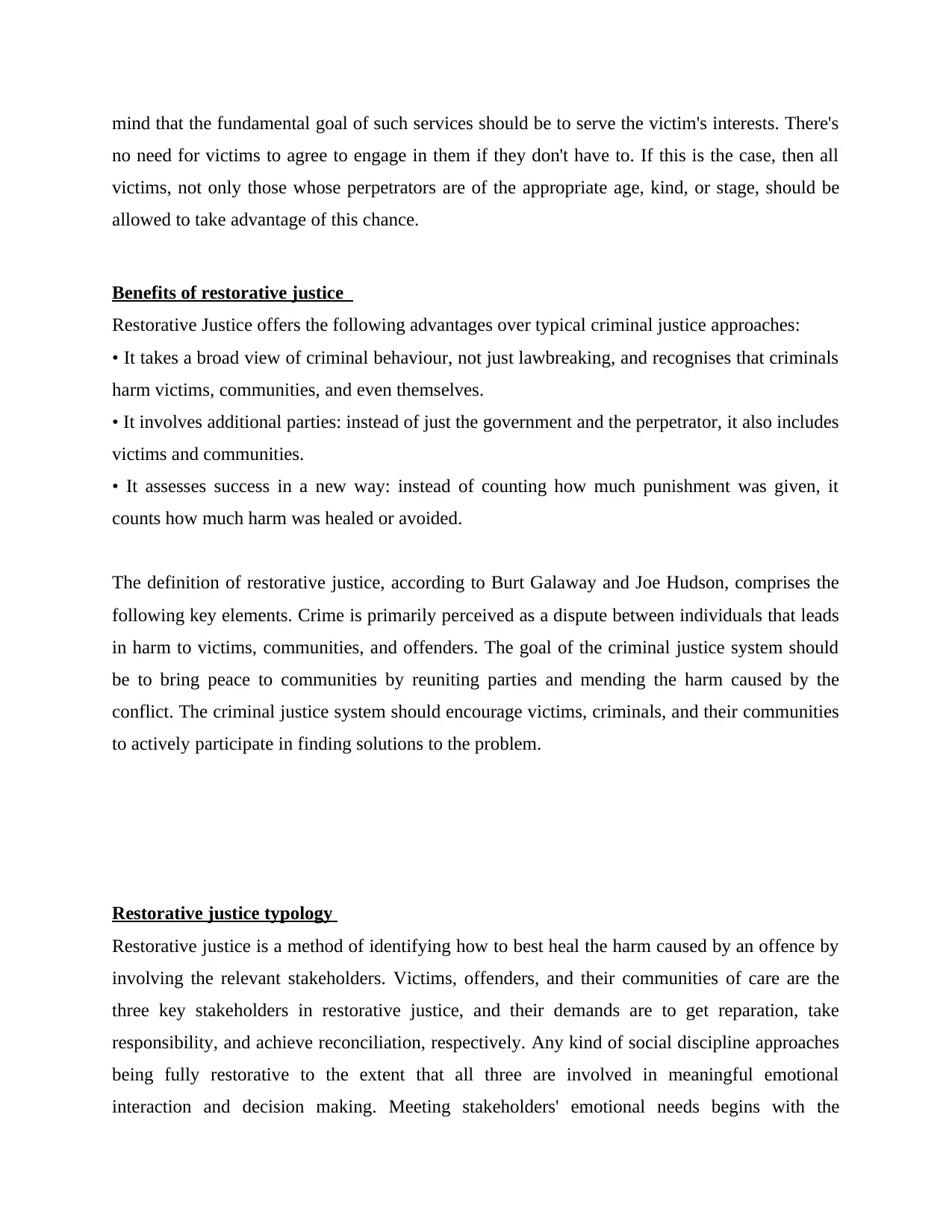
mind that the fundamental goal of such services should be to serve the victim's interests. There's
no need for victims to agree to engage in them if they don't have to. If this is the case, then all
victims, not only those whose perpetrators are of the appropriate age, kind, or stage, should be
allowed to take advantage of this chance.
Benefits of restorative justice
Restorative Justice offers the following advantages over typical criminal justice approaches:
• It takes a broad view of criminal behaviour, not just lawbreaking, and recognises that criminals
harm victims, communities, and even themselves.
• It involves additional parties: instead of just the government and the perpetrator, it also includes
victims and communities.
• It assesses success in a new way: instead of counting how much punishment was given, it
counts how much harm was healed or avoided.
The definition of restorative justice, according to Burt Galaway and Joe Hudson, comprises the
following key elements. Crime is primarily perceived as a dispute between individuals that leads
in harm to victims, communities, and offenders. The goal of the criminal justice system should
be to bring peace to communities by reuniting parties and mending the harm caused by the
conflict. The criminal justice system should encourage victims, criminals, and their communities
to actively participate in finding solutions to the problem.
Restorative justice typology
Restorative justice is a method of identifying how to best heal the harm caused by an offence by
involving the relevant stakeholders. Victims, offenders, and their communities of care are the
three key stakeholders in restorative justice, and their demands are to get reparation, take
responsibility, and achieve reconciliation, respectively. Any kind of social discipline approaches
being fully restorative to the extent that all three are involved in meaningful emotional
interaction and decision making. Meeting stakeholders' emotional needs begins with the
no need for victims to agree to engage in them if they don't have to. If this is the case, then all
victims, not only those whose perpetrators are of the appropriate age, kind, or stage, should be
allowed to take advantage of this chance.
Benefits of restorative justice
Restorative Justice offers the following advantages over typical criminal justice approaches:
• It takes a broad view of criminal behaviour, not just lawbreaking, and recognises that criminals
harm victims, communities, and even themselves.
• It involves additional parties: instead of just the government and the perpetrator, it also includes
victims and communities.
• It assesses success in a new way: instead of counting how much punishment was given, it
counts how much harm was healed or avoided.
The definition of restorative justice, according to Burt Galaway and Joe Hudson, comprises the
following key elements. Crime is primarily perceived as a dispute between individuals that leads
in harm to victims, communities, and offenders. The goal of the criminal justice system should
be to bring peace to communities by reuniting parties and mending the harm caused by the
conflict. The criminal justice system should encourage victims, criminals, and their communities
to actively participate in finding solutions to the problem.
Restorative justice typology
Restorative justice is a method of identifying how to best heal the harm caused by an offence by
involving the relevant stakeholders. Victims, offenders, and their communities of care are the
three key stakeholders in restorative justice, and their demands are to get reparation, take
responsibility, and achieve reconciliation, respectively. Any kind of social discipline approaches
being fully restorative to the extent that all three are involved in meaningful emotional
interaction and decision making. Meeting stakeholders' emotional needs begins with the
Secure Best Marks with AI Grader
Need help grading? Try our AI Grader for instant feedback on your assignments.

interaction process(Maglione, 2019). Only one set of stakeholders may participate in the
emotional exchange required to address the needs of all those immediately affected. All three
groups of major stakeholders must actively participate in the most healing processes.
Restorative justice programs
Restorative programmes are based on given values:
• Encounter: Set up meetings for victims, offenders, and community members who wish to talk
about the incident and its repercussions.
• Amends: Expect offenders to make amends for the harm they have caused;
• Reintegration: Attempt to reintegrate victims and offenders into society as entire, contributing
members;
• Inclusion: Allow parties with an interest in a specific crime to participate in its resolution.
A number of programmes have become associated with restorative justice because of the
processes they use to respond to and repair the harm caused by crime:
Victim Offender Mediation
A meeting between the victim and the offender is facilitated by a qualified mediator in
the Victim Offender Mediation programme. The victim and offender undertake conflict
resolution and develop their own way to achieving justice in the face of their specific crime with
the support and assistance of the mediator. Both parties are given an equal opportunity to voice
their thoughts and feelings about the crime. The meetings end with an attempt to achieve an
agreement on steps the offender will take to repair the victim's harm and "make things right" in
other ways. The victim's participation is frequently characterised as voluntary, as is the offender's
engagement, though it should be noted that offenders may "volunteer" in order to avoid more
onerous results that might otherwise be imposed. Unlike binding arbitration, the mediator does
not impose a certain decision. Instead, the mediator's function is to enable communication
between the victim and the offender, with both taking a proactive role in finding a fair outcome
for both parties. Client satisfaction, victim engagement, and restitution completion rates are all
emotional exchange required to address the needs of all those immediately affected. All three
groups of major stakeholders must actively participate in the most healing processes.
Restorative justice programs
Restorative programmes are based on given values:
• Encounter: Set up meetings for victims, offenders, and community members who wish to talk
about the incident and its repercussions.
• Amends: Expect offenders to make amends for the harm they have caused;
• Reintegration: Attempt to reintegrate victims and offenders into society as entire, contributing
members;
• Inclusion: Allow parties with an interest in a specific crime to participate in its resolution.
A number of programmes have become associated with restorative justice because of the
processes they use to respond to and repair the harm caused by crime:
Victim Offender Mediation
A meeting between the victim and the offender is facilitated by a qualified mediator in
the Victim Offender Mediation programme. The victim and offender undertake conflict
resolution and develop their own way to achieving justice in the face of their specific crime with
the support and assistance of the mediator. Both parties are given an equal opportunity to voice
their thoughts and feelings about the crime. The meetings end with an attempt to achieve an
agreement on steps the offender will take to repair the victim's harm and "make things right" in
other ways. The victim's participation is frequently characterised as voluntary, as is the offender's
engagement, though it should be noted that offenders may "volunteer" in order to avoid more
onerous results that might otherwise be imposed. Unlike binding arbitration, the mediator does
not impose a certain decision. Instead, the mediator's function is to enable communication
between the victim and the offender, with both taking a proactive role in finding a fair outcome
for both parties. Client satisfaction, victim engagement, and restitution completion rates are all

high for this programme, which results in less fear among victims and less criminal behaviour by
offenders(Maglione, 2020)..
Conferencing
In that it involves the victim and offender in an extensive discourse regarding the crime
and its effects, this programme is similar to victim-offender reconciliation/mediation
programmes to some extent. In addition to the victim and perpetrator, these programmes include
participation from families, police, social welfare officials, attorneys, and others. Conferencing
programmes bring together a diverse collection of people to show the juvenile offender that
many people care about him or her and to teach a feeling of responsibility to his or her family,
social circle, and society. The positive value of "re-integrative shame," in which the community
denounces the offender's behaviour as wrong while affirming their commitment to the offender
and their active desire to reintegrate him/her back into society, is critical to this approach.
Conferencing is only employed when the perpetrator admits to his or her guilt (or in some
jurisdictions, admits liability or declines to deny guilt). It is not used to decide guilt, and the
offender may choose to end the conference and continue to court for a traditional decision of
guilt or innocence at any time during the procedure(Rossner and Bruce, 2018)..
offenders(Maglione, 2020)..
Conferencing
In that it involves the victim and offender in an extensive discourse regarding the crime
and its effects, this programme is similar to victim-offender reconciliation/mediation
programmes to some extent. In addition to the victim and perpetrator, these programmes include
participation from families, police, social welfare officials, attorneys, and others. Conferencing
programmes bring together a diverse collection of people to show the juvenile offender that
many people care about him or her and to teach a feeling of responsibility to his or her family,
social circle, and society. The positive value of "re-integrative shame," in which the community
denounces the offender's behaviour as wrong while affirming their commitment to the offender
and their active desire to reintegrate him/her back into society, is critical to this approach.
Conferencing is only employed when the perpetrator admits to his or her guilt (or in some
jurisdictions, admits liability or declines to deny guilt). It is not used to decide guilt, and the
offender may choose to end the conference and continue to court for a traditional decision of
guilt or innocence at any time during the procedure(Rossner and Bruce, 2018)..
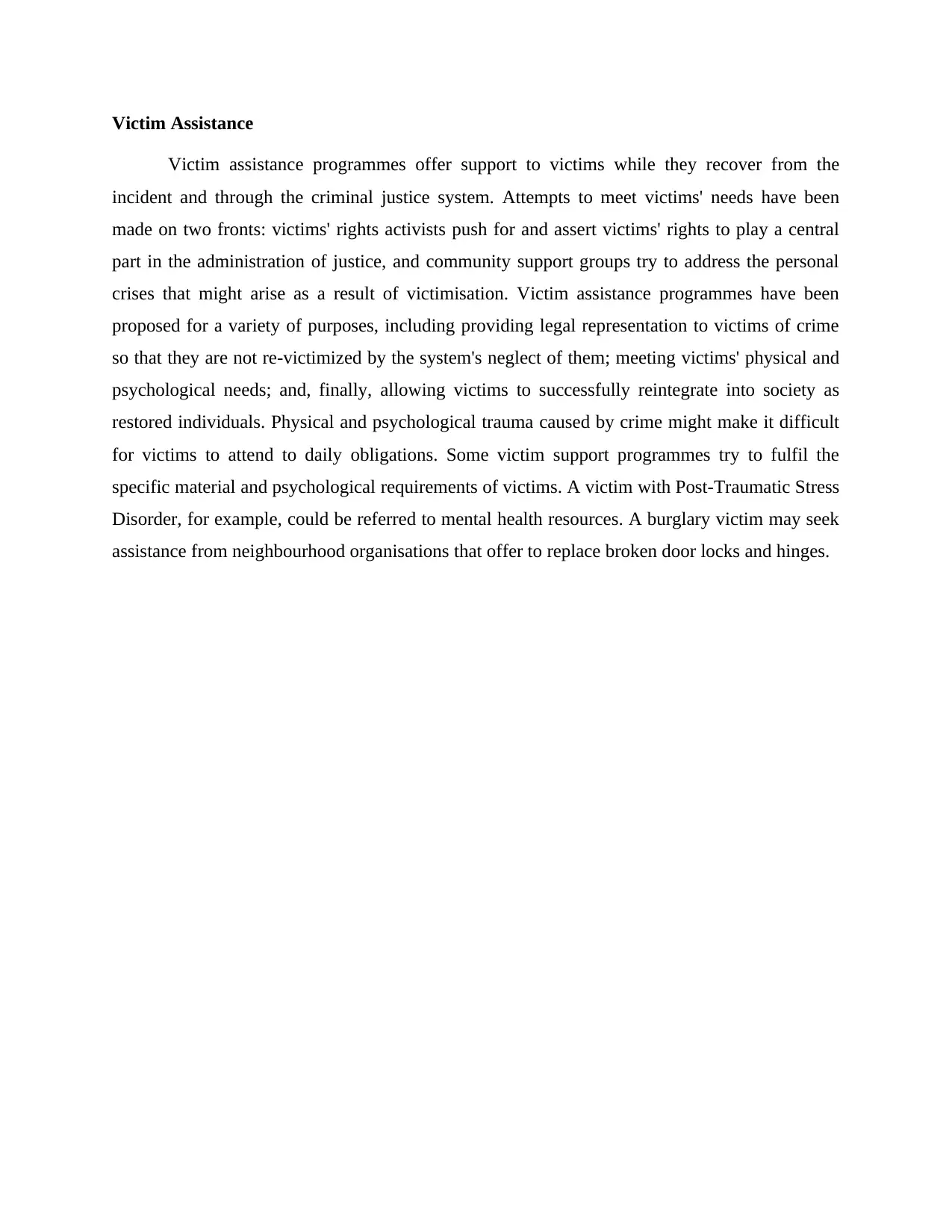
Victim Assistance
Victim assistance programmes offer support to victims while they recover from the
incident and through the criminal justice system. Attempts to meet victims' needs have been
made on two fronts: victims' rights activists push for and assert victims' rights to play a central
part in the administration of justice, and community support groups try to address the personal
crises that might arise as a result of victimisation. Victim assistance programmes have been
proposed for a variety of purposes, including providing legal representation to victims of crime
so that they are not re-victimized by the system's neglect of them; meeting victims' physical and
psychological needs; and, finally, allowing victims to successfully reintegrate into society as
restored individuals. Physical and psychological trauma caused by crime might make it difficult
for victims to attend to daily obligations. Some victim support programmes try to fulfil the
specific material and psychological requirements of victims. A victim with Post-Traumatic Stress
Disorder, for example, could be referred to mental health resources. A burglary victim may seek
assistance from neighbourhood organisations that offer to replace broken door locks and hinges.
Victim assistance programmes offer support to victims while they recover from the
incident and through the criminal justice system. Attempts to meet victims' needs have been
made on two fronts: victims' rights activists push for and assert victims' rights to play a central
part in the administration of justice, and community support groups try to address the personal
crises that might arise as a result of victimisation. Victim assistance programmes have been
proposed for a variety of purposes, including providing legal representation to victims of crime
so that they are not re-victimized by the system's neglect of them; meeting victims' physical and
psychological needs; and, finally, allowing victims to successfully reintegrate into society as
restored individuals. Physical and psychological trauma caused by crime might make it difficult
for victims to attend to daily obligations. Some victim support programmes try to fulfil the
specific material and psychological requirements of victims. A victim with Post-Traumatic Stress
Disorder, for example, could be referred to mental health resources. A burglary victim may seek
assistance from neighbourhood organisations that offer to replace broken door locks and hinges.
Paraphrase This Document
Need a fresh take? Get an instant paraphrase of this document with our AI Paraphraser

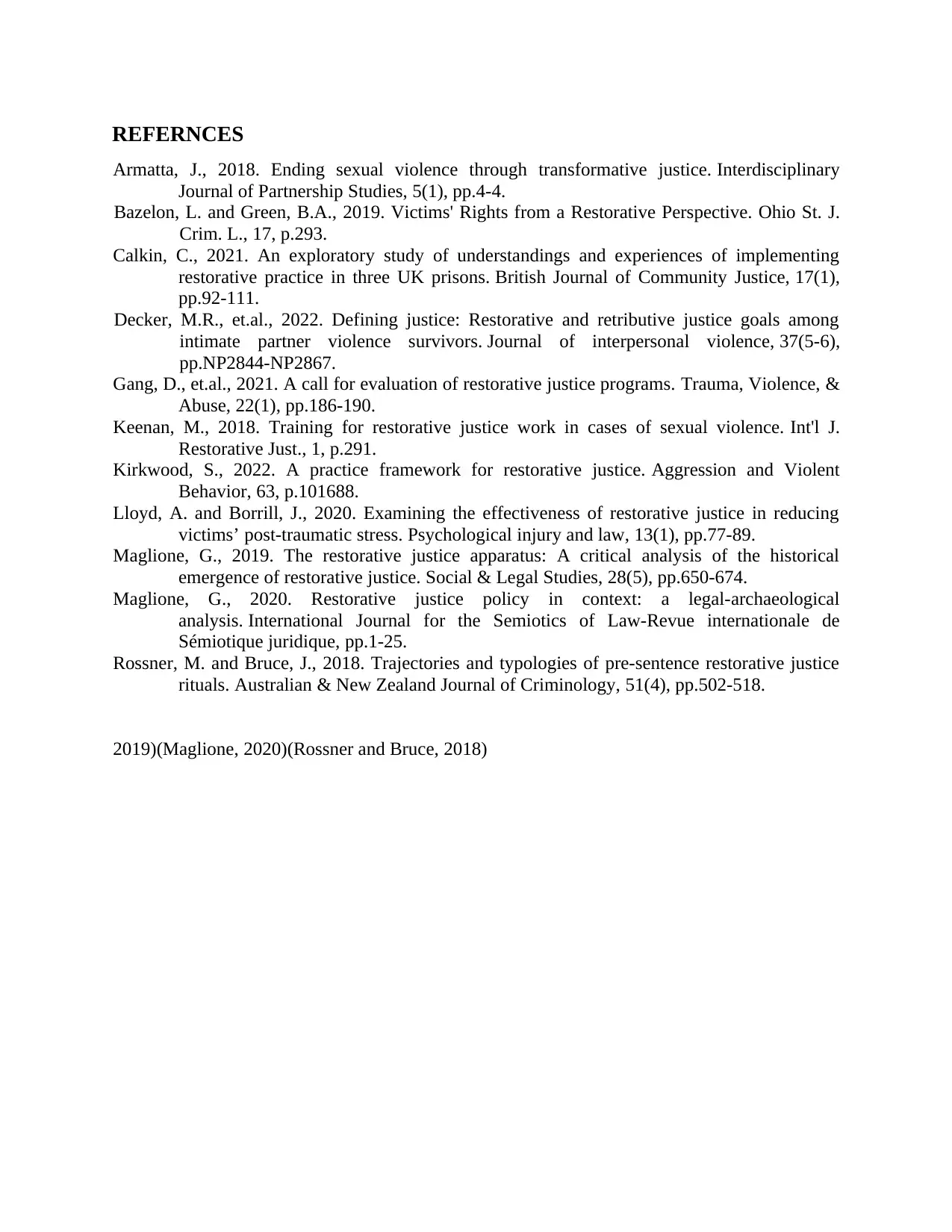
REFERNCES
Armatta, J., 2018. Ending sexual violence through transformative justice. Interdisciplinary
Journal of Partnership Studies, 5(1), pp.4-4.
Bazelon, L. and Green, B.A., 2019. Victims' Rights from a Restorative Perspective. Ohio St. J.
Crim. L., 17, p.293.
Calkin, C., 2021. An exploratory study of understandings and experiences of implementing
restorative practice in three UK prisons. British Journal of Community Justice, 17(1),
pp.92-111.
Decker, M.R., et.al., 2022. Defining justice: Restorative and retributive justice goals among
intimate partner violence survivors. Journal of interpersonal violence, 37(5-6),
pp.NP2844-NP2867.
Gang, D., et.al., 2021. A call for evaluation of restorative justice programs. Trauma, Violence, &
Abuse, 22(1), pp.186-190.
Keenan, M., 2018. Training for restorative justice work in cases of sexual violence. Int'l J.
Restorative Just., 1, p.291.
Kirkwood, S., 2022. A practice framework for restorative justice. Aggression and Violent
Behavior, 63, p.101688.
Lloyd, A. and Borrill, J., 2020. Examining the effectiveness of restorative justice in reducing
victims’ post-traumatic stress. Psychological injury and law, 13(1), pp.77-89.
Maglione, G., 2019. The restorative justice apparatus: A critical analysis of the historical
emergence of restorative justice. Social & Legal Studies, 28(5), pp.650-674.
Maglione, G., 2020. Restorative justice policy in context: a legal-archaeological
analysis. International Journal for the Semiotics of Law-Revue internationale de
Sémiotique juridique, pp.1-25.
Rossner, M. and Bruce, J., 2018. Trajectories and typologies of pre-sentence restorative justice
rituals. Australian & New Zealand Journal of Criminology, 51(4), pp.502-518.
2019)(Maglione, 2020)(Rossner and Bruce, 2018)
Armatta, J., 2018. Ending sexual violence through transformative justice. Interdisciplinary
Journal of Partnership Studies, 5(1), pp.4-4.
Bazelon, L. and Green, B.A., 2019. Victims' Rights from a Restorative Perspective. Ohio St. J.
Crim. L., 17, p.293.
Calkin, C., 2021. An exploratory study of understandings and experiences of implementing
restorative practice in three UK prisons. British Journal of Community Justice, 17(1),
pp.92-111.
Decker, M.R., et.al., 2022. Defining justice: Restorative and retributive justice goals among
intimate partner violence survivors. Journal of interpersonal violence, 37(5-6),
pp.NP2844-NP2867.
Gang, D., et.al., 2021. A call for evaluation of restorative justice programs. Trauma, Violence, &
Abuse, 22(1), pp.186-190.
Keenan, M., 2018. Training for restorative justice work in cases of sexual violence. Int'l J.
Restorative Just., 1, p.291.
Kirkwood, S., 2022. A practice framework for restorative justice. Aggression and Violent
Behavior, 63, p.101688.
Lloyd, A. and Borrill, J., 2020. Examining the effectiveness of restorative justice in reducing
victims’ post-traumatic stress. Psychological injury and law, 13(1), pp.77-89.
Maglione, G., 2019. The restorative justice apparatus: A critical analysis of the historical
emergence of restorative justice. Social & Legal Studies, 28(5), pp.650-674.
Maglione, G., 2020. Restorative justice policy in context: a legal-archaeological
analysis. International Journal for the Semiotics of Law-Revue internationale de
Sémiotique juridique, pp.1-25.
Rossner, M. and Bruce, J., 2018. Trajectories and typologies of pre-sentence restorative justice
rituals. Australian & New Zealand Journal of Criminology, 51(4), pp.502-518.
2019)(Maglione, 2020)(Rossner and Bruce, 2018)
1 out of 15
Related Documents
Your All-in-One AI-Powered Toolkit for Academic Success.
+13062052269
info@desklib.com
Available 24*7 on WhatsApp / Email
![[object Object]](/_next/static/media/star-bottom.7253800d.svg)
Unlock your academic potential
© 2024 | Zucol Services PVT LTD | All rights reserved.





